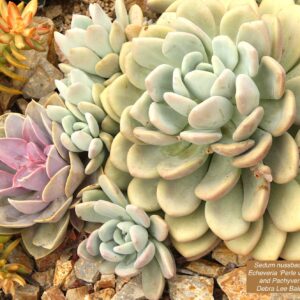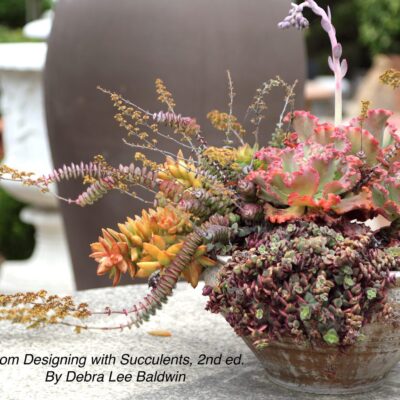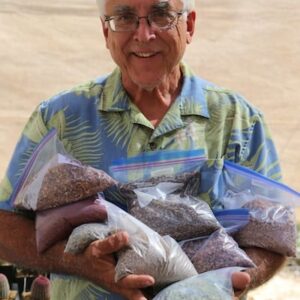When you saw "mistakes beginners make with succulents," you probably though the first would be "overwatering." There's so much angst about watering succulents! Yet watering is one of the simplest things about this type of plant: Forget to do it and it'll probably be fine.
So, are we good? No? All righty, let's start with Mistake Number One:

Desiccated paddle cactus. It'll plump when the rains come.
1. Assuming they're no-water plants
Succulents are low-water plants. Water thoroughly; wait until dry or nearly; repeat. When in doubt, don't. If they shrivel, they're trying to tell you something. See How to Water Succulents.
2. Misting the plants
Hm. To what end? Succulents come from arid climates, not foggy ones...except for a very few that grow on coastal cliffs. Most don't collect, absorb, need or want moisture-laden air.
3. Adding pebbles to nondraining pots
This supposedly provides the drainage succulents famously need. Yet what it does is create a microbial soup that eventually rots the roots. This may be counter-intuitive, but most succulents do fine without drainage if you keep soil dry and water only enough to moisten the roots.

The euphorbia needs less water than the sedum. Pick one, because the other probably won't make it.
4. Combining succulents that have different needs
If you put mammillarias in a pot with sedums, you're basically making a floral arrangement. Stonecrop needs more water and less sun than cactus. Enjoy the pretty pairing, but don't expect it to last.

Fenestraria (baby toes)
5. Starting out with living rocks or moon cactus
Succulents with personality make owners nurturers, but such plants are challenging even for experts. I'll never forget when my baby toes died. (I was 11.)
6. No top dressing
Gardens and pots look better if soil is covered, and gravel or pebbles also have practical purposes: They slow moisture evaporation, moderate soil temperature, diffuse rain, help keep weeds from sprouting (and make them easier to pull if they do). Learn more about top dressing.

A sunburned kalanchoe.
7. Not acclimating nursery plants
If your new succulent was under shade cloth or in a greenhouse, don't immediately place it in full sun. It'll burn, and you'll wonder what those beige patches are. Introduce new plants to greater sun gradually. Read more about sun and succulents.

These century plants may look great now, but they'll eventually triple in size.
8. Not knowing how big it'll get
The header photo shows Euphorbia ammak 'Variegata' encroaching on a home's eves. But arguably a worse mistake is planting Agave americana pups alongside a curb, walkway, steps or driveway. Learn more.

Aloe nobilis in low light and in full sun.
9. Giving succulents too little light
Put a red or orange aloe in the shade, and it'll revert to green. The plant will be OK, but you'll be disappointed. Same for crassulas and echeverias: Sun is essential for color...and flowering.
8. Ignoring mealy bugs
Suddenly they're everywhere, especially when potted succulents are crammed together. Check leaf axils for white bits, spray pests with Isopropyl alcohol (70%), and isolate or discard infested plants. See the "Pest and Damage Control" section of Designing with Succulents (2nd ed), pp. 137-143.

Bunny ears (Opuntia microdasys) is polka-dotted with glochids.
9. Being unaware of glochids
Opuntia (paddle cacti, prickly pear) typically have spines you can see plus glochids ("glock-ids")---hairlike, hooked ones you almost can't. With the slightest touch they detach from the plant and imbed your skin.
10. Not knowing plants' origins
You may not be able to give your cacti the desert Southwest, but understanding that they come from a dry, hot, sunny region with cold winter nights will go a long way to making them---and you---happy.
The Secret to Happy Succulents
The secret to happy succulents is to duplicate their native growing conditions as much as possible. The more you know about where a succulent comes from, the easier you can do this…up to a point. Occasionally (not often) it’s nearly impossible. No matter what you do, saguaros don’t thrive beyond the Sonoran Desert, where they…
How Much Light Do Succulents Need?
How much light do your succulents need? It depends on the type of plant and where you live. Most haworthias and gasterias prefer shade but can handle some sun along the coast. Many but not all cacti are fine in full desert sun. As a general rule, the majority of soft-leaved succulents want half a day’s sun (in mild climates) and dappled or “bright” shade.
Use Crushed-Rock Top Dressing to Enhance Your Succulent Designs
Do consider using crushed-rock top dressing to enhance your succulent designs. In the ground or in pots, your succulent compositions will look and perform better if bare soil doesn’t show. Top dressing lends a finished look, and plants benefit from the way it disperses water. In the open garden, soil exposed to sunlight is likely…
The post Succulents: What Not to Do appeared first on Debra Lee Baldwin. Copyright © Debra Lee Baldwin.
from Debra Lee Baldwin https://ift.tt/2W0ZOW6
via IFTTT




No hay comentarios:
Publicar un comentario